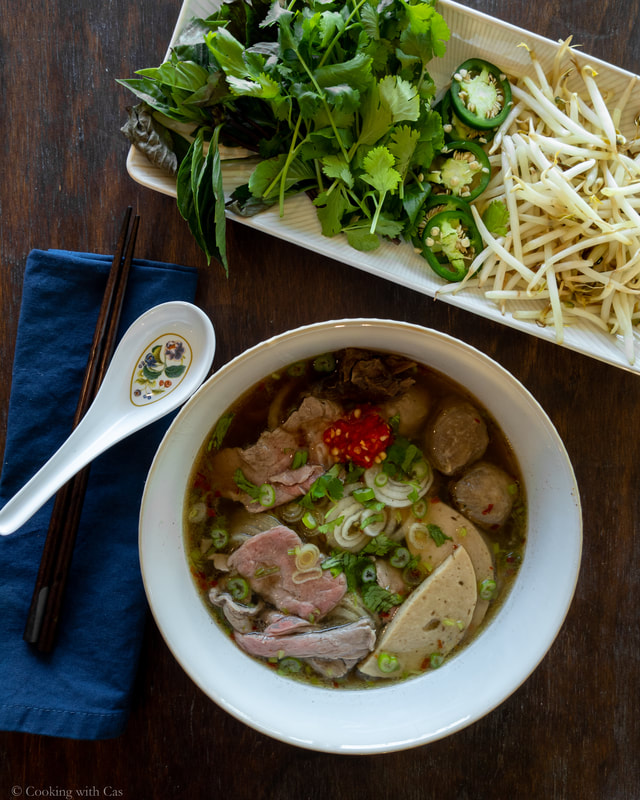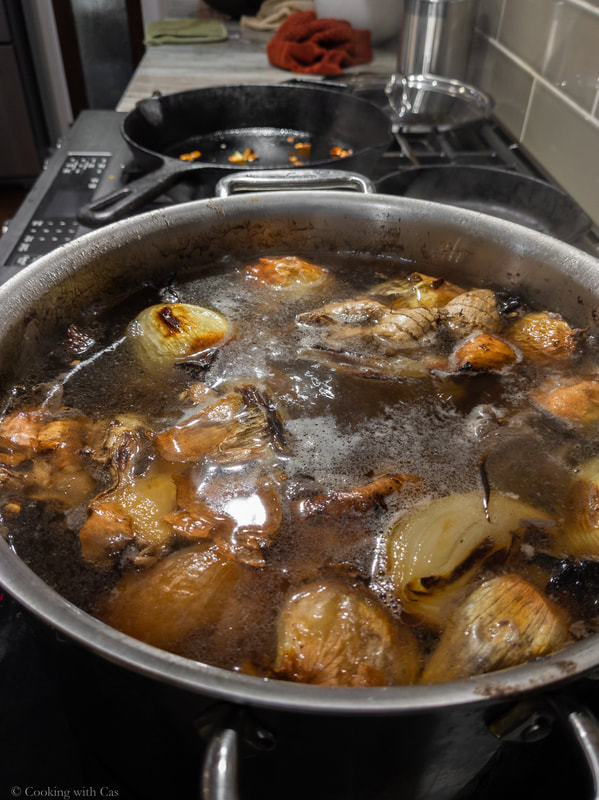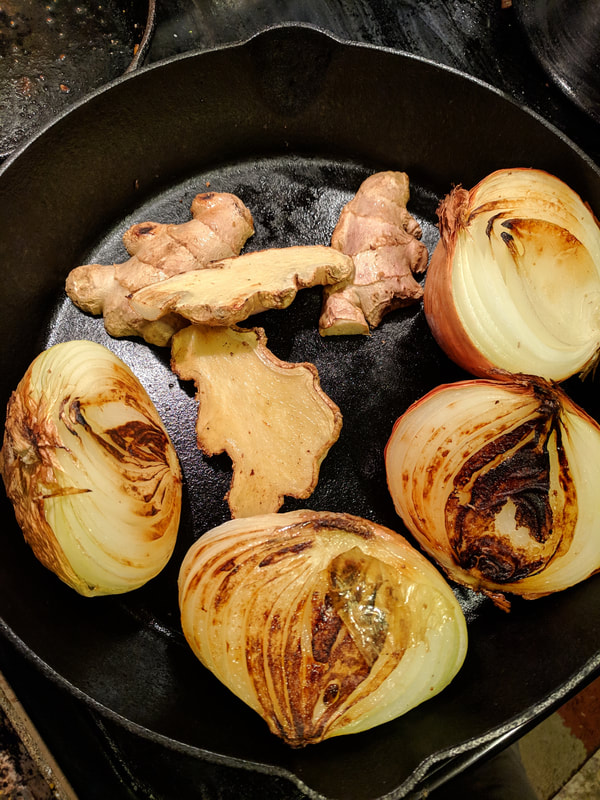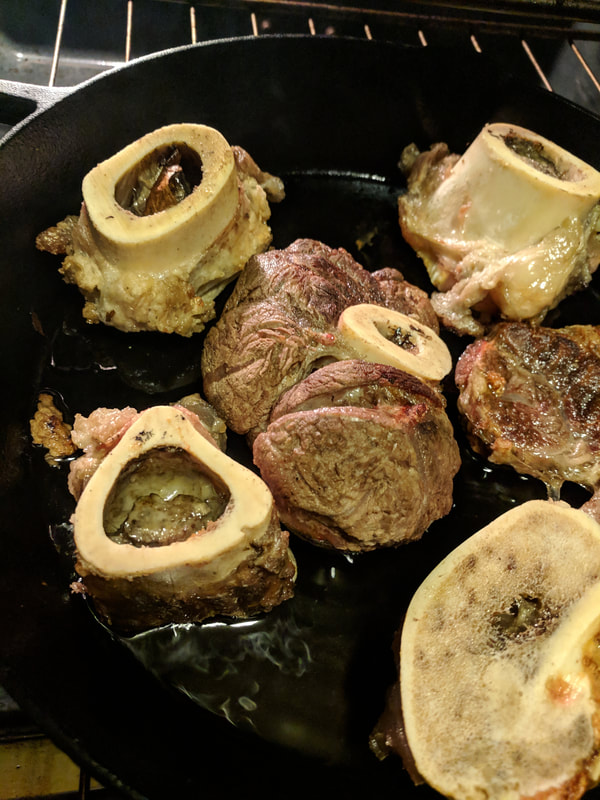"Maybe it's a pheromonic thing, like love at first sight, but for me, a good bowl of phở will always make me happy."
- Anthony Bourdain, c. 2009
- Anthony Bourdain, c. 2009
|
Arguably, *the* signature dish of Vietnam really needs little to no introduction. Phở bò is the unctuous bowl of beef broth, piled high with aromatics and rice noodles, to be enjoyed at any time of day. There is even a lot to learn from this dish as it applies to French imperialism and how the Vietnamese people utilized certain ingredients like an excess of beef bones during colonialist eras throughout history.
There are plenty of "cheater phở" recipes online. There are similarly some appropriative recipes that really miss the mark on what phở really is - I hope to provide this recipe as a contrast to those white-washed instances and off-the-mark recipes. Don't take shortcuts (although a pressure cooker could speed up the process a bit); It's simply not worth it. Do your due diligence and monitor that pot of deliciously fatty, silky broth with your finest mesh sieve, and keep it from boiling over. Luckily, this makes about 3 full meals worth of broth, so you can easily stock up in the freezer for instant phở gratification. The pictured phở is technically a phở bò viên tái chả lụa (beef phở with meatballs, medium-rare beef, and pork meatloaf), but feel free to use whatever cuts of beef you like. It's fluid (GET IT) enough to handle any cut of beef from brisket to chunks of tendon to rare beef. Shopping List (for the broth/soup):
|
Spices (for your bouquet sachet):
|
Prep:
Preheat your oven to about as hot as it can get - I go with 475+ deg F (you can optionally roast the onions and ginger over a gas burner if that's available to you). Get a big cast iron skillet in there. You want this one ripping hot. You can even go with a convection setting in your oven for added efficiency.
Slice both the ginger and onions in half. Don't bother peeling them. The char on the outside is beneficial to your end goal, and will also lend a great color to the end product.
Carefully remove the cast iron pan from the oven. Get a thin coat of oil over your onions and ginger and place them into the preheated pan, cut side down. Let these roast until good color (read: CHAR) develops and your house is just emanating aromatics, this should take at least 30 minutes. Then evacuate to a bowl to slightly cool. You don't necessarily have to peel the ginger or onions before adding it to the pot, and it all gets strained out anyway.
You can optionally roast the bones as well - the traditional path here is to simply parboil the bones for a few minutes, rinse/wash them off, and return with a fresh pot of water. Roasting the bones will make the broth cloudier but slightly more beefy, where the parboil route is a much cleaner, clearer, and subtle broth (sometimes I do this roasting step, sometimes I don't), but if there's any meat or fat left on the bones, leave it on. More flavor, more Maillard reaction and gelatin from the connective tissue in the meat.
Optionally, prepare your bouquet sachet by wrapping the cinnamon stick, a few cloves, and star anise pod in some cheesecloth and tie with butcher's twine. I often skip this, as everything gets
Starting with cold water, combine the roasted bones, onions, and ginger, and the package of spices into that big ass pot. Bring it up to an almost boil to get the initial impurities out of the bones if you didn't parboil them first and went with a roasted option. Then bring it down to a simmer. Low simmer.
Hear that alarm going off? IT'S TIME TO SKIM YOUR LIFE AWAY!
As the broth bubbles away (especially for the first hour), a layer of coagulated proteins will form on the surface of your pot from the upward convection pressure of the water *just* boiling off. Any bits of brown, excess foam, anything that doesn't look like it should be there; get it out with your soup skimmer. A spoon will also work if you don't mind the somewhat higher skill it takes to do so. If your pot is simmering away, then you should see any impurities, and gunk float to the edge of your pot. Did I mention that this should not be a hard boil by any means?
After a good amount of scum has been skimmed off, stir in the fish sauce, palm sugar, salt, and MSG. This is the entirety of salt that you'll be adding, and the rest of the ingredients remain unsalted, so if your stock is tasting strong, that is good. It will become more dilute as you build the actual bowls themselves.
I recommend simmering for at least 3 hours. There's no real upper limit to how long you can simmer it, but obviously there are only 24 hours in a day. I assume you want to eat this at some point, right? At the same time, you can easily get away with a late-night phở broth if you only have 3-4 hours total to spare. An hour or so to roast the onions and bring the water to a boil, and then 2-3 hours to make the stock.
Once your stock is sufficiently velvety in texture from it reducing and simmering for some indefinite amount of time, take it off the heat. You're not eating this phở today, sorry to break it to you. Broths and stocks are always less complex in flavor immediately off the stock pot; if you let this sit overnight in the fridge you can accomplish two things: a) as any cooking stock cools, the proteins that were broken down in the cooking process begin to recombine into more complex amalgamations of amino acids and chemical compounds, and thus flavors. If you eat/drink fresh stock you are only getting the simplest of amino acid flavor(s) (note: this isn't a bad thing if you're in a rush, but you've already taken the time to make phở stock at home, you can wait some more time) b) chilling overnight allows you to de-fat the stock, to then uniformly redistribute it throughout your serving/storage plans. If you were to pour directly off the top after chilling, you will end up with a non-uniform fat layer in the last bowl that you pour.
Grab a few large bowls. Fish out the beef bones into a bowl, and set aside. In a separate bowl, strain the stock through a few layers of cheesecloth molded over a fine mesh sieve. This will catch the last little chunks of material that would otherwise cloud your stock. Squeeze the onions and ginger as much as you can to release all of their flavor (why would you waste this?), and I suggest washing out the original pot to chill this in the fridge overnight (make sure you have the lid, too).
I like to save the shank bones, especially if there's still some residual meat, tendon, and connective tissue on them. It will be easier to peel that off when it has cooled, though.
The Business:
Otherwise, once your stock has cooled, you're ready to assemble your bowl(s) of phở.
Cook your banh phở noodles. The wider varieties will have you boil them like any dried pasta, but be sure to check your specific brand, to be safe.
In a 4 qt saucepan, gently heat about 1.5 c of broth per serving, a few Tbsp of chopped cilantro stems, a pinch of red chili flake, the whites of your green onion, the slices of Chả lụa pork, and your Bò Viên meatballs until warm (the Vietnamese meatballs will generally come fully cooked, they just need to be warmed, similarly for the pork meatloaf).
Get all of your desired garnishes ready. Start soaking the sliced yellow onions in water (I like to slice them on a mandolin slicer, but a knife works well too), you can blanch bean sprouts for a few seconds in hot water, slice green chilies, tear off bunches of basil, grab handfuls of cilantro at a time. Go to town on it all, there's no such thing as an overloaded bowl.
In a large bowl (I'm not joking, your largest bowl), place the banh phở noodles in the bottom, followed by a layer of yellow onion, and then any raw sliced round on top of that. Spoon the broth over the round to cook it as you go, and then garnish with the rest of the meatballs and pork. Top with more cilantro, the scallion greens, some pickled chilies and garlic, you name it.
Oh, and wear some clothes you don't mind getting deliciously velvety broth all over.
Dig in. Enjoy.
Preheat your oven to about as hot as it can get - I go with 475+ deg F (you can optionally roast the onions and ginger over a gas burner if that's available to you). Get a big cast iron skillet in there. You want this one ripping hot. You can even go with a convection setting in your oven for added efficiency.
Slice both the ginger and onions in half. Don't bother peeling them. The char on the outside is beneficial to your end goal, and will also lend a great color to the end product.
Carefully remove the cast iron pan from the oven. Get a thin coat of oil over your onions and ginger and place them into the preheated pan, cut side down. Let these roast until good color (read: CHAR) develops and your house is just emanating aromatics, this should take at least 30 minutes. Then evacuate to a bowl to slightly cool. You don't necessarily have to peel the ginger or onions before adding it to the pot, and it all gets strained out anyway.
You can optionally roast the bones as well - the traditional path here is to simply parboil the bones for a few minutes, rinse/wash them off, and return with a fresh pot of water. Roasting the bones will make the broth cloudier but slightly more beefy, where the parboil route is a much cleaner, clearer, and subtle broth (sometimes I do this roasting step, sometimes I don't), but if there's any meat or fat left on the bones, leave it on. More flavor, more Maillard reaction and gelatin from the connective tissue in the meat.
Optionally, prepare your bouquet sachet by wrapping the cinnamon stick, a few cloves, and star anise pod in some cheesecloth and tie with butcher's twine. I often skip this, as everything gets
Starting with cold water, combine the roasted bones, onions, and ginger, and the package of spices into that big ass pot. Bring it up to an almost boil to get the initial impurities out of the bones if you didn't parboil them first and went with a roasted option. Then bring it down to a simmer. Low simmer.
Hear that alarm going off? IT'S TIME TO SKIM YOUR LIFE AWAY!
As the broth bubbles away (especially for the first hour), a layer of coagulated proteins will form on the surface of your pot from the upward convection pressure of the water *just* boiling off. Any bits of brown, excess foam, anything that doesn't look like it should be there; get it out with your soup skimmer. A spoon will also work if you don't mind the somewhat higher skill it takes to do so. If your pot is simmering away, then you should see any impurities, and gunk float to the edge of your pot. Did I mention that this should not be a hard boil by any means?
After a good amount of scum has been skimmed off, stir in the fish sauce, palm sugar, salt, and MSG. This is the entirety of salt that you'll be adding, and the rest of the ingredients remain unsalted, so if your stock is tasting strong, that is good. It will become more dilute as you build the actual bowls themselves.
I recommend simmering for at least 3 hours. There's no real upper limit to how long you can simmer it, but obviously there are only 24 hours in a day. I assume you want to eat this at some point, right? At the same time, you can easily get away with a late-night phở broth if you only have 3-4 hours total to spare. An hour or so to roast the onions and bring the water to a boil, and then 2-3 hours to make the stock.
Once your stock is sufficiently velvety in texture from it reducing and simmering for some indefinite amount of time, take it off the heat. You're not eating this phở today, sorry to break it to you. Broths and stocks are always less complex in flavor immediately off the stock pot; if you let this sit overnight in the fridge you can accomplish two things: a) as any cooking stock cools, the proteins that were broken down in the cooking process begin to recombine into more complex amalgamations of amino acids and chemical compounds, and thus flavors. If you eat/drink fresh stock you are only getting the simplest of amino acid flavor(s) (note: this isn't a bad thing if you're in a rush, but you've already taken the time to make phở stock at home, you can wait some more time) b) chilling overnight allows you to de-fat the stock, to then uniformly redistribute it throughout your serving/storage plans. If you were to pour directly off the top after chilling, you will end up with a non-uniform fat layer in the last bowl that you pour.
Grab a few large bowls. Fish out the beef bones into a bowl, and set aside. In a separate bowl, strain the stock through a few layers of cheesecloth molded over a fine mesh sieve. This will catch the last little chunks of material that would otherwise cloud your stock. Squeeze the onions and ginger as much as you can to release all of their flavor (why would you waste this?), and I suggest washing out the original pot to chill this in the fridge overnight (make sure you have the lid, too).
I like to save the shank bones, especially if there's still some residual meat, tendon, and connective tissue on them. It will be easier to peel that off when it has cooled, though.
The Business:
Otherwise, once your stock has cooled, you're ready to assemble your bowl(s) of phở.
Cook your banh phở noodles. The wider varieties will have you boil them like any dried pasta, but be sure to check your specific brand, to be safe.
In a 4 qt saucepan, gently heat about 1.5 c of broth per serving, a few Tbsp of chopped cilantro stems, a pinch of red chili flake, the whites of your green onion, the slices of Chả lụa pork, and your Bò Viên meatballs until warm (the Vietnamese meatballs will generally come fully cooked, they just need to be warmed, similarly for the pork meatloaf).
Get all of your desired garnishes ready. Start soaking the sliced yellow onions in water (I like to slice them on a mandolin slicer, but a knife works well too), you can blanch bean sprouts for a few seconds in hot water, slice green chilies, tear off bunches of basil, grab handfuls of cilantro at a time. Go to town on it all, there's no such thing as an overloaded bowl.
In a large bowl (I'm not joking, your largest bowl), place the banh phở noodles in the bottom, followed by a layer of yellow onion, and then any raw sliced round on top of that. Spoon the broth over the round to cook it as you go, and then garnish with the rest of the meatballs and pork. Top with more cilantro, the scallion greens, some pickled chilies and garlic, you name it.
Oh, and wear some clothes you don't mind getting deliciously velvety broth all over.
Dig in. Enjoy.



